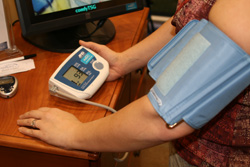Home Health Care — Who Cares?
 There are some categories in AV that become ubiquitous and define the entire channel. DVD and flat panel displays come to mind as easy examples.
There are some categories in AV that become ubiquitous and define the entire channel. DVD and flat panel displays come to mind as easy examples.
Then there are products that transform the landscape almost as soon as they arrive, creating an entire new device ecosystem and clobbering its predecessors. The best example of that would the iPad and its impact on non-tablet touchpanel automation interfaces and, well, pretty much everything else.
Then there are products are categories that are widely recognized as being “a good idea” but never really seeing the traction in the marketplace that their supporters might have hoped for. While this will probably garner me some hate mail from certain PR flacks, energy management for automation systems seems to fit into this bracket.
Lastly, you have emergent categories where it remains to be seen whether they’ll see something resembling success or turn out to be all Sturm und Drang, with little real adoption.
I’m sorry to say, it’s starting to look like Home Health Care is the latter.
Let’s back up for a minute, and start with some definitions. For those of you who’ve been solely focused on AV and more standard control system fodder like shades and lighting, the pitch for Home Health Care is that there are 100 million people is the U.S. who are reaching retirement age. At the same time, there’s reported to be a shortage of health care professionals. Enter the prospect of remote monitoring of health care.
It’s important to further clarify what that means. As far as most people are concerned, Home Health Care is synonymous with PERS, the Personal Injury Service. Most people of a certain age recall the tagline “I’ve fallen, and I can’t get up!” That’s reactive technology: You push a button and something happens. The solutions that are encompassed by HHC are proactive, preventative solutions.
HHC’s boosters put it in the context of ongoing wellness: using the feedback and data from the system for preventative care.
That includes medication management, and GPS-enabled reporting as well as solutions that monitor blood pressure, bodyweight, movement around the house, including frequency of bathroom breaks and sleep patterns, which provide care givers with a more complete picture of a subject’s well-being.
The selling points that have been used to build interest in the category is that there is a large potential client base, which points to the potential for recurring revenue, as well the nature of the category’s technology. With the variables involved in personalizing HHC to end users, it’s challenging to be a turnkey technology, which would apparently make it ideal for integrators: It’s just more black boxes to program and monitory.
The biggest problem I foresee as it relates to HHC gaining traction amongst AV integrators is that the integration channel is not HHC’s first kick at the cat at finding a channel, and not its last either.
If you ask them, HHC’s promoters will tell you that early on in the category’s development, circa 2005 or so, the first attempts of the main HHC startups was through the healthcare industry. A lot of work went into educating that market, but the hurdle they have yet to get over, especially with long term health care facilities like senior’s residences is the perception that HHC is a replacement for trained and qualified personnel, rather than a new set of tools to improve standards of care.
While HHC vendors are still working on that channel, in the meantime they’ve spent the last couple of years promoting the category to the AV integrator channel, most notably in their partnership with CEDIA, and CEDIA’s formation of a committee to promote the benefits of HHC to its members.
That’s where I came in, having spent a few years in the trade media for AV, and having interviewed HHC executives and PR people, and written a few articles here and there along lines of “Home Health Care Is Coming, Hurray!”
The net result so far in AV integration seems to mirror HHC’s inroads in the healthcare industry: not much.
Which is why I find myself unsurprised to see Home Health Care companies working hard to promote their category to an entirely different channel: the Mobile industry (where I work now, having moved over from AV almost two years ago).
The Mobile/Wireless sector of CES, as well as dedicated Mobile shows in the past year have seen delegations of HHC vendors marketing their technology’s “potential” to suppliers and resellers of smartphones and related products. Interestingly, and perhaps again unsurprisingly, the sales pitch their using on Mobile companies is almost exactly what they were pitching to AV integrators: gadgets and recurring revenue.
As Yogi Berra said, “it’s like déjà vu all over again.”
So far, talking with my peers in Mobile, the reception that HHC is receiving is lukewarm, at best.
Is Home Health Care ever going to gain traction any channel? I’m averse to being the guy who says “Never!” about anything, but so far at least HHC hasn’t caught fire in two channels and it’s starting to look like the third time won’t be the charm either.
What will it take? I’d be keen to hear from someone who thinks they know.
Lee Distad is a rAVe columnist and freelance writer covering topics from CE to global business and finance in both print and online. Reach him at lee@ravepubs.com





